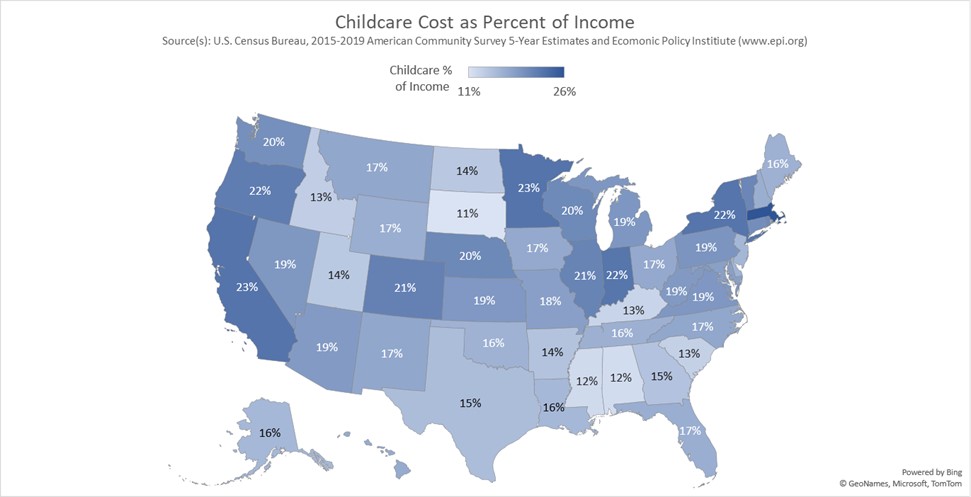As a new Dad, I was shocked by the cost of childcare! I remembered babysitters getting paid $3 per hour when I was a kid, so that was my frame of reference until I had kids of my own. Boy was this a shock… The below details are meant to help level-set expectant Dads as to the realities of the cost of childcare. We have also presented some strategies for working parents to consider to help minimize these costs.
Expected Childcare Costs
Childcare tends to be the largest expense brought on by a new baby. New families are either forgoing a salary of one partner to stay home with the child or seeking outside care for their child while at work. If you happen to have trusted family or friends that will help for free or little cost, hold on to them as they are invaluable (start planning now for a killer birthday gift).
As we documented in our 2021 Cost for a New Child article, the average family can expect to spend $1,150 a month per child in childcare costs in 2021. The average family in the United States spend 17.6% of their Income on Childcare and there are 14 states where you will see 20 cents of every dollar you earn going to childcare. Getting this right is not only important for your budget, but also so key to your child’s development and safety as they will spend the bulk of your workweek with their childcare provider.

Strategies to Reduce Childcare Costs
From an economic standpoint there are some things that can be done to offset some of this expense.
- Take advantage of parental leave options with your employer. Some employers (and states) offer parental leave options that allow for leave that can be used anytime within the first year of the child’s life. If this is the case, consider staggering the leave so that one parent can have their leave right after the childbirth (typically the mother) and the other have their leave when the first partners expires. This will delay the start of daycare and allow for early developmental time with both parents. Also, be strategic on your use of your vacation days, as this can supplement a parental leave option (if offered in addition to parental leave from your employer).
- Utilize seasonal work schedules to your benefit where possible. If you work in an industry that has a seasonal schedule like education, tourism/hospitality, some construction, some retail, etc. seek a childcare that will allow your off season to go unpaid while still guaranteeing a space when you return. This may be easier said than done as markets with a heavy demand on childcare often have limitations on “unpaid” time allowed. If that is the case, consider an option that will cover your child up to the start of your off-season and then a potential different option that you can move to after your off-season concludes.
- Take advantage of flexible work plans if offered by your employer. If you have the option to work four 10-hour days verse five 8-hour days, you can reduce your childcare cost by roughly 20% (4 days verse 5 days). If both parents have this option, you can reduce childcare by 40% by setting your schedules so only 3 of your 4 workdays overlap.
- Stagger work schedules. If you work in industries that allow shift work or weekend work, you and your partner can stagger schedules, so that you ensure one parent is home as much as possible to lighten the need for childcare. Try to do this while still maintaining a strong connection with your spouse.
- Work from home. With the increasing acceptance in work-from-home positions, look for a job that allows for this flexibility (or ask your current employer). This can limit the time needed for external childcare. You may be able to start work early (while your partner is still home to care for the child) or work later into the evening (while your partner is back home) to allow for only half-day childcare verse the full days needed when working outside of the house. Also, remember that you will not be driving to and from work, which may free up an hour or two in your day to get your work done.
- Share in daycare responsibilities with co-workers, friends, or neighbors. If you have a network of families with similar aged kids, explore a group strategy that minimize external daycare costs. Look at group plans or if a rotating in-home option makes sense based on working schedules.
- Shop around and do your research. There are many different types of childcare options available (in home, external, nanny, au-pair, etc.). Do your research to understand what provides your family with the safety and value that you desire.
Stay Connected with your Spouse
Remember that childcare costs will significantly minimize as your kids grow up. Once they hit kindergarten, childcare costs could be a thing of the past through public education. Your primary planning is for a 5-year stretch, that would start once parental leave is exhausted. Through that 5 years, the plan may change quite a bit, as the childcare needs for a newborn are vastly different than the needs for a toddler.
Do your research and don’t be afraid to bounce ideas off your employer as companies are learning they must be much more family friendly to accommodate the modern workforce. Also, be sure to keep your connection with your partner. Be cautious in stretching your schedules just to offset childcare costs. Marital harmony must be maintained to keep a healthy household. It can be tough for new parents to stay connected, so keep a strong grip on your relationship while making these big decisions!
